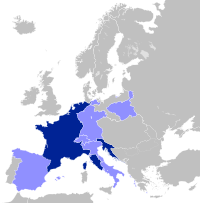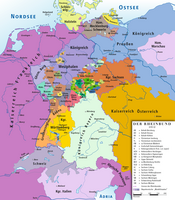Act Of Confederation
This article has multiple issues. Please help improve it or discuss these issues on the talk page. (Learn how and when to remove these messages)
|
Confederated States of the Rhine | |||||||||
|---|---|---|---|---|---|---|---|---|---|
| 1806–1813 | |||||||||
 The Confederation of the Rhine in 1812 | |||||||||
| Status | Confederation of client states of the French Empire | ||||||||
| Capital | Frankfurt | ||||||||
| Common languages | German, French | ||||||||
| Religion | |||||||||
| Demonym(s) | Rhenish | ||||||||
| Government | Confederated French client states | ||||||||
| Protector | |||||||||
• 1806–1813 | Napoleon I | ||||||||
| Prince-Primate | |||||||||
• 1806–1813 | Karl von Dalberg | ||||||||
• 1813 | E. de Beauharnais | ||||||||
| Legislature | Diet | ||||||||
| Historical era | Napoleonic Wars | ||||||||
• Treaty of the Confederation of the Rhine | 12 July 1806 | ||||||||
• Holy Roman Empire dissolved | 6 August 1806 | ||||||||
• Dissolved after Battle of Leipzig | 4 November 1813 | ||||||||
| |||||||||
| Today part of | Germany Liechtenstein Austria | ||||||||
The Confederated States of the Rhine, simply known as the Confederation of the Rhine or Rhine Confederation, was a confederation of German client states established at the behest of Napoleon some months after he defeated Austria and Russia at the Battle of Austerlitz. Its creation brought about the dissolution of the Holy Roman Empire shortly afterward. The Confederation of the Rhine lasted for only seven years, from 1806 to 1813, dissolving after Napoleon's defeat in the War of the Sixth Coalition.
The founding members of the confederation were German princes of the Holy Roman Empire. They were later joined by 19 others, altogether ruling a total of over 15 million people. This granted a significant strategic advantage to the French Empire on its eastern frontier by providing a buffer between France and the two largest German states, Prussia and Austria (which also controlled substantial non-German lands).
Background
After the Treaty of Lunéville, which saw the annexation of the German territories of the left bank of the Rhine occupied by France, a new order of Central European states was established. The Final Imperial Recess of 1803 led to a radical transformation within the Holy Roman Empire. Some 112 immediate territories east of the Rhine were absorbed by larger states. Over three million people were affected by this change. All ecclesiastical territories save one were secularized and most free imperial cities underwent mediatisation. Besides Prussia, the Electorate of Baden and the Duchy of Württemberg benefited the most from these changes. The disappearance of ecclesiastical territories meant the emperor lost important political support. The end of the crippled Holy Roman Empire was foreseeable. Francis II took the title of Emperor of Austria in 1804 to counter the loss of prestige. When the War of the Third Coalition broke out in 1805, with Russia, Austria and Great Britain on the one side and France on the other, Bavaria, Baden and Wurttemberg allied with Napoleon.
After the victory at Austerlitz and the resultant Peace of Pressburg in 1805, Napoleon could significantly reassert his position in the German states. Furthermore, Austria had to concede territory and Napoleon named his brothers Joseph and Louis kings of Naples and Holland, respectively, and his brother-in-law Joachim Murat, Grand Duke of Berg. He also worked toward establishing an alliance with Baden, Bavaria and Württemberg. Francis II had to assent to the elevation of both Bavaria and Württemberg to the rank of kingdom and Baden, Hesse-Darmstadt and Berg to that of grand duchy. With French encouragement, the vestiges of small Imperial estates in the region were annexed. This reorganisation of the right bank of the Rhine laid the groundwork for the Confederation of the Rhine.
Formation
| History of Germany |
|---|
 |
The formation of the Confederation of the Rhine was not altogether a voluntary option for its future member states. Negotiations between France and the princes who had been selected by Napoleon to be members of the future alliance had been dragging on for the first six months of 1806 when Napoleon decided to rush things. On 12 July, the Paris envoys of the various princes were summoned to the ministry of Foreign Affairs to find themselves instructed by Talleyrand to sign the treaty of the new alliance, whose terms had been decided between him and Napoleon. This caused consternation among the envoys given that the terms were far more onerous for the princes than what had been expected. They all protested that they were not empowered to sign before their masters authorized them to do so, but Talleyrand compelled them to sign then and there and so they did under duress. King Maximilian Joseph of Bavaria, who alone among the princes had been sent a copy of the proposed treaty, was aghast. Among other things, Bavaria would lose control of its foreign policy which would now be in the hands of Napoleon, the "Protector of the Confederation" . He hurriedly sent Baron Karl von Gravenreuth to Paris with instructions to reject a confederation which he said gave to the Protector a power "more extensive than the Emperor of Germany ever had". Von Gravenreuth was detained long enough at the French border so that when he finally arrived in Paris all the other princes had signed. He therefore found it unadvisable to deliver the King’s views on the matter. In the words of Enno E. Kraehe: "Only by such crude methods was Napoleon able at last to found the Confederation of the Rhine".
On signing the Treaty of the Confederation of the Rhine (German: Rheinbundakte), 16 German states joined in a loose confederation of sovereign states (the treaty called it the États confédérés du Rhin. The "Protector of the Confederation" was a hereditary office of the Emperor of the French, Napoleon. On 1 August, as the treaty compelled them to do, the members of the confederation formally seceded from the Holy Roman Empire, and on 6 August, following an ultimatum by Napoleon, Francis II, who had already proclaimed himself Emperor of Austria in 1804, declared the Holy Roman Empire dissolved.

According to the treaty, the confederation was to be run by common constitutional bodies, but the individual states (in particular the larger ones) wanted unlimited sovereignty. Instead of a monarchical head of state, as the Holy Roman Emperor had been, its highest office was held by Karl Theodor von Dalberg, the former Arch Chancellor, who now bore the title of a Prince-Primate of the confederation. As such, he was President of the College of Kings and presided over the Diet of the Confederation, designed to be a parliament-like body although it never actually assembled. The President of the Council of the Princes was the Prince of Nassau-Usingen.
In return for their support of Napoleon, some rulers were given higher statuses: Baden, Hesse, Cleves, and Berg were made into grand duchies, and Württemberg and Bavaria became kingdoms. Several member states were also enlarged with the absorption of the territories of Imperial counts and knights who were mediatized at that time. They had to pay a very high price for their new status, however. The Confederation was above all a military alliance; the member states had to maintain substantial armies for mutual defense and supply France with large numbers of military personnel. As events played out, the members of the confederation found themselves more subordinated to Napoleon than they had been to the Habsburgs when they were within the Holy Roman Empire. In order to add luster to his newly-founded dynasty, the French Emperor pressed hard to arrange a marriage between his step-son Eugène de Beauharnais and Augusta of Bavaria. Napoleon had already contemplated marrying Beauharnais to a Wittelsbach princess in 1804 but it’s only in 1806, following his elevation to the status of king, that Max Joseph gave in to Napoleon’s pressure. Other royal marriages were arranged between Stéphanie de Beauharnais and Charles of Baden and Jérôme Bonaparte and Catharina of Württemberg.
After Prussia lost to France in 1806, Napoleon cajoled most of the secondary states of Germany into the Confederation of the Rhine. Eventually, an additional 23 German states joined the Confederation. It was at its largest in 1808, when it included 36 states—four kingdoms, five grand duchies, 13 duchies, seventeen principalities, and the Free Hansa towns of Hamburg, Lübeck, and Bremen. The west bank of the Rhine and the Principality of Erfurt had been annexed outright by the French Empire. Thus, as either emperor of the French or protector of the Confederation of the Rhine, Napoleon was now the overlord of all of Germany except Austria, Prussia, Danish Holstein, and Swedish Pomerania, plus previously independent Switzerland, which were not included in the Confederation.
In 1810 large parts of what is now northwest Germany were quickly annexed to France in order to better monitor the trade embargo with Great Britain, the Continental System.
The Confederation of the Rhine collapsed in 1813, in the aftermath of Napoleon's failed invasion of the Russian Empire. Many of its members changed sides after the Battle of Leipzig, when it became apparent Napoleon would lose the War of the Sixth Coalition.
Types of states within the Confederation
Both French influence and internal autonomy varied greatly throughout the confederation's existence. There was also a great variation between the power and influence of the individual states. There are three basic types:
- The first group formed the "Model States", which were mostly ruled by relatives of Napoleon. These include the Kingdom of Westphalia under Jérôme Bonaparte. The Grand Duchy of Berg was first administered by Joachim Murat before he was appointed King of Naples in 1808, and then by Napoleon himself. The third model state was the Grand Duchy of Frankfurt, which was run by the house of Dalberg until 1813. Because of the collapse of the Napoleonic supremacy, this position could no longer justify its own existence. These new foundations were intended to serve as a model for the remaining Rhine federal states through their legal and social policies, such as the Napoleonic Code.
- The second group were the reform states of Bavaria, Württemberg, Baden, and Hesse-Darmstadt. These were not dependent areas but in many ways Napoleon's true allies. Although these states took inspiration from the French model, they also went their own way. The historian Lothar Gall suggested that the rulers of the Confederation of the Rhine were made revolutionaries by Napoleon himself. Opposition to the emperor would have been possible only by renouncing the power that he had given to them. "He had not made satellites which were politically incapable of action and forced to be obedient through use of force, but real allies who followed in his well-understood policy reasons of state."
- A third group formed the states that joined after 1806. These included the numerous smaller northern and central German territories, except for Saxony. In these, the internal changes were minimal. The reforms remained significantly limited in these states. However, there were also considerable differences among these states. In Mecklenburg and Saxony, the old structures remained almost unchanged. In the Duchy of Nassau, on the other hand, Minister Ernst Franz Ludwig Marshal von Bieberstein ensured moderate administrative modernization and the introduction of religious tolerance.
Member monarchies
The following table shows the members of the confederation, with their date of joining, as well as the number of troops provided, listed in parentheses.


